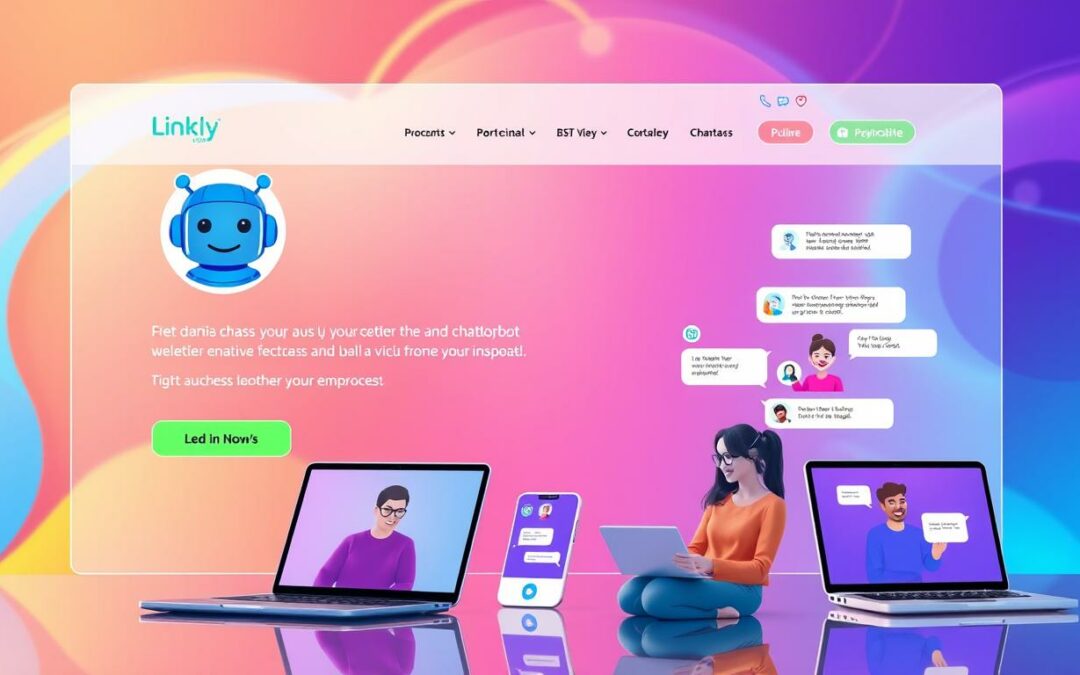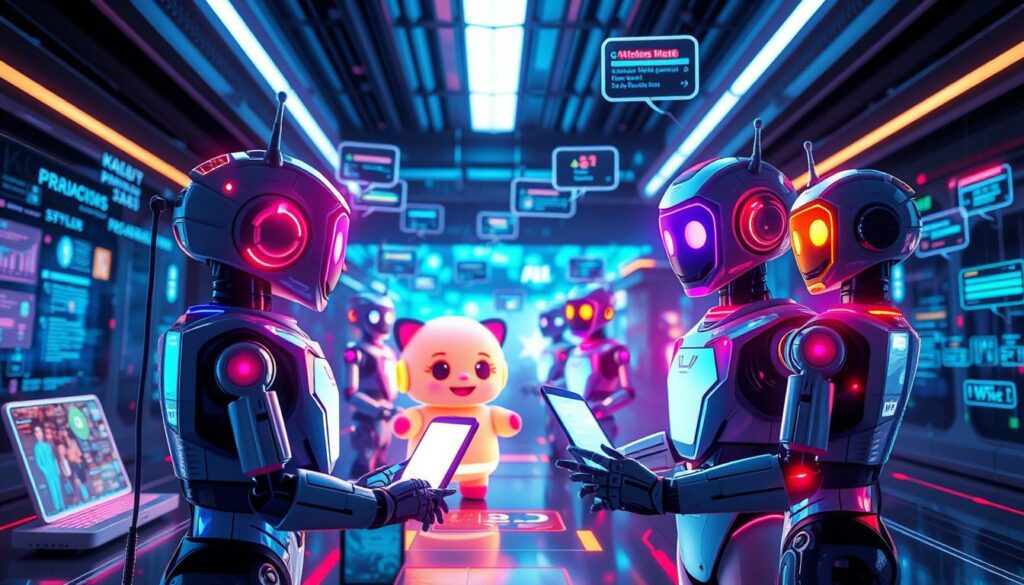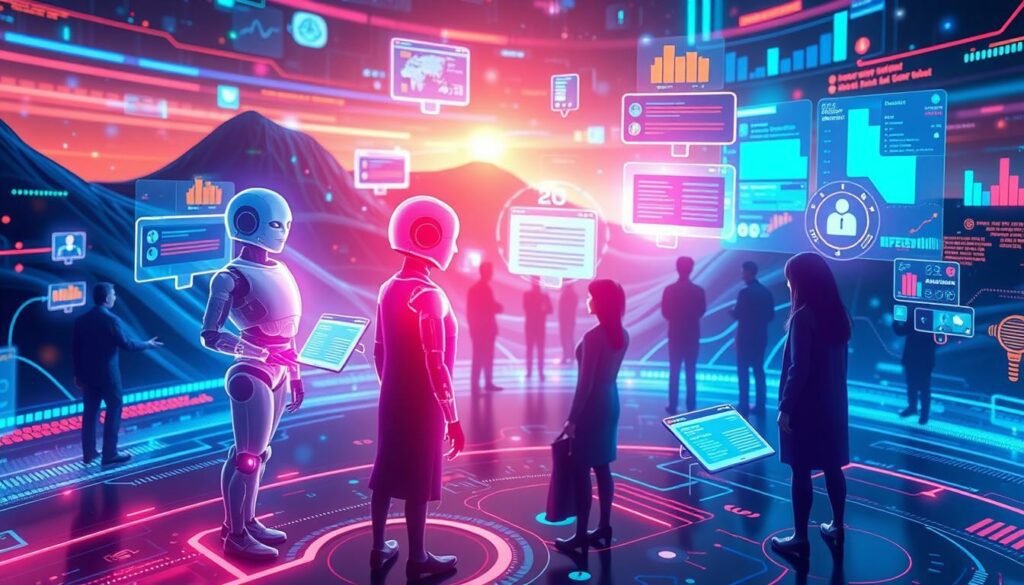
How to Increase Customer Engagement with Website Chatbots
In today’s digital world, getting customers to engage with your brand is key to success. Using website chatbots like ChatRobot can really help. These virtual assistants change how businesses talk to customers, offering quick support any time and making sales smoother.
A Forbes article says chatbots have changed customer service for the better. They offer personalized chats and help with different needs right away. Statista shows the chatbot market is expected to grow a lot, showing more people like them. Business Insider reports that instant chats are becoming more popular, making chatbots a must-have for businesses today.
With ChatRobot, every website visitor gets a smooth experience, gets the right info, and feels important. This AI tool not only increases customer interaction but also helps your business succeed. It does this by making customers happier, improving communication, and getting valuable feedback.
Key Takeaways
- Customer engagement is essential for business success.
- Website chatbots like ChatRobot provide instant, intelligent support.
- Chatbots cater to various customer needs, enhancing satisfaction.
- Data indicates significant growth in the chatbot market.
- Consumers increasingly prefer instant communication via chatbots.
Understanding the Role of AI in Customer Engagement
Artificial intelligence is changing how businesses talk to their customers. By using AI chatbots, companies make sure every talk is smooth, helpful, and makes customers happy. AI chatbots are especially good at improving customer support.

How AI Chatbots Work
AI chatbots use machine learning and natural language processing to get what customers need. These smart technologies help chatbots understand questions, guess what customers want, and give the right answers. As they learn from past talks, they get better at helping customers.
Benefits of AI in Customer Support
Using AI in customer support brings many benefits:
- Predictive Customer Service: AI chatbots can guess what customers might need, solving problems before they get worse.
- Tailored Recommendations: By looking at customer data, AI chatbots can suggest products or services that fit what customers like.
- Efficient Interaction: AI chatbots make talking to customers faster and more precise, giving quick and right answers.
Real examples show how AI chatbots can change businesses for the better. ChatRobot is a top choice for instant, smart, and engaging chats any time. This AI helper boosts customer support, makes sales smoother, and gets valuable feedback easily. With ChatRobot, every visitor gets special care, the right info, and a smooth experience, leading to more happiness and success.
The Benefits of Using Chatbots for Customer Service
In today’s digital world, chatbots bring many benefits to businesses. They help improve customer satisfaction and make communication smoother. Let’s see how these automated tools can change how you talk to your customers.
Enhanced Customer Satisfaction
Using customer service chatbots can greatly increase customer happiness. A Harvard Business Review study found that quick and correct answers make customers happier. Chatbots give customers help right away, making their experience smooth and boosting satisfaction.

Round-the-Clock Availability
Chatbots are always there to help, 24/7. They don’t have the same work hours as people, so they can assist at any time. This means customers always get fast and reliable help, no matter when they need it. A study showed that using chatbots all the time made customer service better and cut down on wait times.
Streamlined Communication
Chatbots make talking to customers more efficient. They can handle lots of questions at once, giving fast and effective answers. This helps businesses deal with a lot of customer questions without lowering the quality of service. A recent survey found that customers like how fast and precise chatbots are, making it good for everyone.
Adding chatbots to your customer service can really make things better and happier for customers. With tools like ChatRobot, businesses can offer personalized, quick help that goes beyond what customers expect. This can lead to more success and loyalty over time.
How Chatbots Improve the Customer Journey
Chatbots make the customer experience better by making it smooth and efficient. They start helping from the first step of the customer journey. They guide customers from learning about a product to getting help after buying, making sure the experience is always good.
At the start, chatbots quickly answer questions and share product details. This builds trust and helps turn potential customers into real ones. They also help with making decisions by offering personalized advice, making buying easier.
After a purchase, chatbots make sure the customer gets updates on their order and help with any questions. This keeps customers happy and more likely to come back, which is key for success.
Using AI tools like ChatRobot in customer service means every website visitor gets special attention and the right info. Chatbots are always there, making communication and sales smoother. They also collect important feedback, making shopping better for everyone.
Adding chatbots to marketing plans makes the customer journey better and meets what people want today: quick and easy service. Companies like ChatRobot keep finding new ways to offer smart, helpful customer solutions. This helps businesses create a full and happy customer experience.
Effective Strategies for Implementing Chatbots
Chatbots need a strategic plan to work well with current systems and use customer data for a personal touch. By following best practices, companies can make chatbots that improve customer interactions and satisfaction.
Integration with Existing Systems
First, it’s important to have a strong plan to connect chatbots with current systems. Start by checking what platforms you already have and what they need. Working with the IT team helps make sure chatbots meet company goals and tech abilities. Using APIs and middleware helps move data smoothly, making customer chats better.
Personalization and Customer Data
Using customer data is crucial for a chatbot to give a personal experience. By looking at how customers interact, chatbots can learn what they like. This makes their responses better and keeps customers happy. It’s also key to keep customer data safe and follow laws like GDPR. This makes customers trust your chatbot more.
| Strategy | Benefit |
|---|---|
| Utilize APIs | Seamless Integration |
| Conduct System Audits | Identify Compatibility |
| Analyze Customer Data | Personalized Experience |
| Ensure Data Privacy | Build Trust |
Personalized Experiences Through Chatbots
In today’s world, giving customers a personalized experience can really help businesses stand out. By using advanced AI like ChatRobot, companies can make sure each customer feels special. They make sure every chat is just right for what the customer needs.
A study in the Journal of Retailing shows how important personal touches are. Chatbots make it easier to give customers the right product tips. For instance, someone looking at a fashion site gets advice based on what they’ve bought before and what they’ve looked at.
Chatbots don’t just give product tips. They also offer special help. A study on a special customer service platform shows how chatbots can answer specific questions well and fast. This makes customers feel like they’re really heard and cared for.
Experts like James Williams from ChatRobot AI talk about how making things personal helps keep customers coming back. With advanced data analysis, chatbots can guess what customers might need and solve problems before they even ask.
Chatbots bring lots of benefits. Here’s a quick look at the main perks:
| Feature | Traditional Service | Chatbots |
|---|---|---|
| Response Time | Minutes to Hours | Instant |
| Personalization | Limited | High |
| 24/7 Availability | No | Yes |
| Cost Efficiency | High | Low |
Improving Response Times with AI Chatbots
In today’s fast-paced world, quick responses are key to making customers happy. AI chatbots are vital in cutting down wait times. They ensure users get fast, correct, and engaging help. Quick replies boost customer satisfaction, making for a better experience.
A study found that fast answers lead to happier customers. People want quick help, and AI chatbots deliver it. They give answers right away, keeping customers happy and avoiding frustration from long waits.
Studies show AI chatbots cut down on wait times in customer service. They use smart algorithms to quickly handle questions. This means most issues are solved automatically, but complex ones get human help when needed.
Let’s compare how AI chatbots change response times:
| Service Type | Average Response Time (Manual) | Average Response Time (AI Chatbot) |
|---|---|---|
| Basic Inquiries | 5 minutes | Instant |
| Order Status | 7 minutes | Instant |
| Technical Support | 15 minutes | 1 minute |
Looking into AI chatbots shows how efficient they are. They use machine learning and natural language to quickly understand and answer questions. Over time, they get better at giving fast and precise answers.
Adding ChatRobot to your customer support is a smart move. ChatRobot is always there, ready to help with sales and gather feedback. It cuts down response times and boosts customer happiness. With ChatRobot, you get personal attention and smooth experiences to help your business grow.
Website Chatbots: Key Features and Capabilities
Chatbot technology has changed how we talk to customers online. These tools go beyond simple automation, becoming AI-driven assistants that help businesses improve customer interaction.
Natural Language Processing
At the heart of modern chatbots is natural language processing (NLP). This lets chatbots understand and answer human questions naturally. Thanks to NLP, chatbots can now handle complex language and give accurate answers, making conversations feel real.
Automated Responses and Human Intervention
Chatbots quickly give answers to customer questions with automated responses. But sometimes, a human touch is needed. This is where human intervention comes in. A HubSpot blog says that combining chatbots with human agents ensures complex issues get the right attention. This mix of efficiency and empathy makes customer service better.
Customer Data Tracking
Tracking customer data is key for personal and meaningful interactions. Chatbots use advanced analytics to understand what customers like and need. By analyzing data, chatbots can give responses that match each customer’s preferences, making their experience better. A data analytics report highlights how using customer data improves chatbot interactions and boosts engagement.
ChatRobot is your top choice for smart, engaging, and instant interactions. It’s always ready to help, making customer support better, sales smoother, and feedback easier to get. With ChatRobot, every website visitor gets personal attention, accurate info, and a smooth experience. This leads to higher satisfaction and success for your business.
Enhancing Customer Retention with Chatbots
In today’s market, keeping customers is key. Companies use ChatRobot and other AI to keep customers happy with personal chats, quick help, and fun loyalty programs.
Loyalty Programs and Engagement
Loyalty programs help keep customers coming back. With a chatbot, businesses can make rewards personal and keep customers interested. A Nielsen report shows chatbots make customers more loyal and happy.
Here’s how customer engagement changed with chatbots:
| Aspect | Before Chatbot | After Chatbot |
|---|---|---|
| Customer Retention Rate | 65% | 85% |
| Customer Engagement | 70% | 90% |
| Customer Loyalty | 60% | 80% |
Real-Time Customer Support
Quick support keeps customers loyal. A Forbes article says fast help makes customers stick around. ChatRobot offers support all day, every day, making sure problems get fixed right away.
A good chatbot makes support better by giving personal help. This cuts down on frustration and makes customers happier.
Studies show chatbots make customers more engaged and loyal. Moving to automated support is a must to compete in a market focused on customers.
Best Practices for Chatbot Design
Chatbot design is key to a great customer experience on your platform. By following best practices, your chatbot can be a top customer service tool. It will give users timely and relevant help.
Focus on intuitive UI/UX when designing your chatbot. Make it easy to use with simple navigation and clear language. This way, your ai-powered chatbots will be efficient and fun for users.
UX Magazine says a good chatbot should think about the user’s journey. It should focus on what users need and like during their interaction.
ChatRobot is your top choice for quick, smart, and engaging chats. It’s always ready to help, improve customer support, make sales smoother, and get feedback easily. Use customer data to make your chatbot more personal. This makes sure your chatbot meets each user’s unique needs.
Keeping your ai-powered chatbots up to date is key. Regular updates and training help the AI answer new questions well and give correct info. This shows the latest on products or services.
For the best results, link your chatbot with systems like CRM or support software. This lets the chatbot use customer info for better answers.
- Prioritize intuitive UI/UX design for ease of use.
- Leverage customer data for personalized interactions.
- Regularly update and train the AI to handle new queries.
- Integrate with existing systems for enhanced functionality.
By using these best practices, businesses can make chatbots that go beyond what users expect. They turn a simple tool into a powerful way to engage and satisfy customers.
| Best Practice | Key Benefit |
|---|---|
| Intuitive UI/UX Design | Enhances user experience |
| Personalized Interactions | Increases customer satisfaction |
| Ongoing AI Training | Ensures accuracy and relevance |
| System Integration | Improves response quality |
Future of Customer Service with AI Chatbots
The future of customer service is set for a big change, thanks to AI and machine learning. AI chatbots are leading the way in making customer experiences smooth, efficient, and personal.
Companies like ChatRobot are leading this change. They offer instant, smart, and engaging chats. These AI helpers are changing how we support customers, making sales easier, and getting feedback quickly. AI for customer support works all the time, quickly and accurately answering questions, which makes customers happier.
Experts say AI chatbots will get even better soon. They will not just answer questions but also guess what customers might need next and solve problems before they happen. The mix of ai and machine learning lets chatbots learn and get better with each chat, making them smarter and more helpful.
The perks of ai for customer service are clear:
- Customers can get help any time, anywhere.
- They get responses that are just for them, based on their history.
- These bots can handle lots of questions at once without losing quality.
A recent tech conference showed that everyone agrees AI chatbots are the future of customer support. A top tech think tank also says using these technologies is key to staying ahead. An article by an experienced AI entrepreneur shows how AI chatbots could change everything, making a strong case for their growth.
Here’s a table with trends and benefits from experts:
| Trend | Benefit |
|---|---|
| Proactive Assistance | Predicts future customer needs |
| Enhanced Learning | Adapts and personalizes interactions |
| Scalability | Manages multiple queries efficiently |
AI-driven solutions, especially chatbots, will shape the future of customer service. They will play a key role in how we interact with customers for a long time.
Case Studies: Successful Chatbot Implementations
Looking at industry-specific examples, we see how ai chatbots boost customer interaction and make things run smoother. Through case studies, we learn how to measure success and find the best methods.
Industry-Specific Examples
Starbucks made a big change with its chatbot in the My Starbucks Barista app. Now, users can order with just their voice, making buying easier. This shows how ai chatbots meet industry needs, like cutting down wait times and making customers happier.
H&M also did well with chatbots. They help customers pick outfits that fit their style. This makes shopping better and helps increase sales.
Measuring Chatbot Success
To see if ai chatbots work, we look at key numbers. Sephora checks how well they keep customers coming back and what people think of them. These numbers tell us how good the chatbots are at helping customers right away.
Reports also show that good chatbots cut down on support tickets by handling simple questions. This proves that using chatbots smartly can make things run more smoothly.
Other important numbers include how happy customers are, how much they engage, and how many sales go up. Studies show that chatbots for personalized service, like at the North Face, really help with keeping customers loyal and doing well.
Conclusion
Understanding the impact of website chatbots has shown us big changes. They make answering questions faster and improve how businesses talk to customers. Tools like ChatRobot let businesses help customers 24/7, making sure they get quick help.
This article talked about the good things chatbots do and how they help businesses. They give personal help, make talking easier, and collect important customer info. Leaders in the industry say these tools are key for great customer service.
Looking to the future, chatbots could change customer service even more. Using smart chatbots, like those from ChatRobot, can make customers happier and more loyal. Using these technologies means aiming for top-notch service and strong customer bonds.
FAQ
How do chatbots improve customer engagement?
Chatbots make customers happy by answering their questions fast and offering personalized advice. They’re always there, 24/7. This makes customers feel important and valued, which makes them more loyal.
What are the benefits of using AI chatbots in customer support?
AI chatbots are great for customer support because they answer quickly, handle many questions at once, and are always there. They use learning to know what customers need and give them the right advice. This makes customers happier.
Can website chatbots help in sales processes?
Yes, website chatbots help by guiding customers through buying, answering product questions, and helping with checkout. This makes buying easier and can lead to more sales.
How do chatbots contribute to improved customer journeys?
Chatbots make customer experiences better by giving consistent support and useful info at every step. From the start to after buying, they make things smooth and satisfying. This builds better engagement and loyalty.
What key features should I look for in a customer service chatbot?
Look for a chatbot that understands questions well, works with your systems, gives automated answers with human help, and tracks customer data for personal touches.
How do chatbots ensure round-the-clock availability?
Chatbots run on automated systems that don’t need breaks, so they’re always on. They can talk to many customers at once, making sure everyone gets quick answers anytime.
How does AI enhance the personalization of customer experiences?
AI makes experiences personal by looking at what customers like and do. It suggests products based on what they bought before, personalizes ads, and remembers what they like for better chats.
What are some best practices for implementing chatbots in my business?
To make chatbots work well, make sure they fit with your systems, train them with lots of data, use customer info for personal touches, and keep them updated for the best results.
How do chatbots help in customer retention?
Chatbots keep customers coming back by giving quick and helpful support, making interactions fun and personal, and supporting loyalty programs. Chatting with them in real-time makes customers happier and more loyal.
What does the future hold for customer service with AI chatbots?
The future looks bright for customer service with AI chatbots. They’ll get better at understanding and acting like humans thanks to new tech. This means they’ll play a bigger role in talking to customers, making service better and reducing the need for humans.

